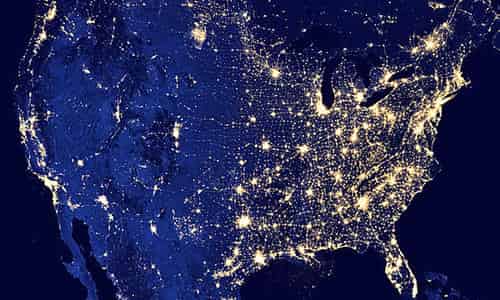Amerageddon: America Without Electricity
 By PNW Staff August 29, 2016
Share this article:
By PNW Staff August 29, 2016
Share this article:
Today we often take our electricity and communications for granted.
The degree to which modern economies and modern societies rely upon
both is staggering with everything from food production and delivery to
pumping the fuel for transportation and the power for communications
completely dependent on electricity.
The quaint belief that we would revert to
the rustic 1800s in the event of a catastrophic interruption to our
power grid is dangerously off the mark too. In the 1800s, we did not
depend on thousand-plus mile food supply chains, electronic banking and
the skill set of the average worker included tasks useful without
electric power, unlike office workers, digital media specialists,
truckers and thousands of other professions today.
While
a localized and short-lived blackout can be dealt with as an emergency
situation and supplies trucked in from outside, a sustained national
blackout would pull society into a lawless dark ages closer to the year
1100 than 1810, accompanied by mass starvation in a society suddenly
unable either to produce or distribute sufficient food.
As
unsettling as a potential grid failure may be, the fact that reliable
electric power has simply always been there makes the issue all too easy
for the public, and the political class, to ignore.
Delta
Airlines offered a small glimpse of the effects of a localized power
outage, cause still unknown, when a blackout at its central offices in
Atlanta, Georgia caused all of its computers across the globe to go
offline on August 8th. All Delta planes were grounded for six hours and
passengers delayed for much longer as flights began to back up.
Economic
crisis has plunged Venezuela into rolling blackouts across wide areas
of the country in the past two years and, in several Venezuelan states,
electricity is being rationed to just a few hours per day when it is
available at all. Food spoils, hospitals go dark, and communications
are silenced. But could worse happen in the United States?
Venezuela
is far from a developed country at this point and if comparisons are to
be made, they only serve to highlight the devastating effects of
mismanagement and neglect. Developed as the US may be, however, a 2014
report from the International Business Times found that "aging
infrastructure and a lack of investment to modernize the grid" has
resulting in the startling fact that the United States experiences more
blackouts than any other developed nation.
Working
from Federal data, the report found that the US now experiences 285%
more blackouts than it did in 1984 when data collection began.
The
electric grid is actually an interconnected network of three majors
grids in the United States: the Western Interconnection, Eastern
Interconnection and the Texas Interconnection. A plant failure or spike
in demand localized in one section of the Eastern Interconnection will
automatically trigger dynamic load balancing within that grid zone but
if the entire grid requires more power, the system is set up to draw
power from the other two interconnection zones.
This
allows demand to be efficiently balanced throughout the system but it
also allows certain types of failures to cascade throughout vast
geographic areas under the right conditions.
There
are three major threats to the US electric grid today: a solar flare, a
manmade electromagnetic pulse and sabotage. A solar flare able to
generate an EMP would be amplified by the length of the electrical
system, overloading transformers and all forms of electronics on an
unprecedented scale.
A manmade EMP, like those
generated from a nuclear blast, would have a similar effect of
overloading circuitry in millions of pieces of electronics of a large
area. But it is cyber-warfare that now a serious threat, as well.
The 2016 election cycle has brought
Russian hacking of the Democratic Party into the headlines, but these
accusations seem relatively benign next to recent uses of computer
viruses as cyber-weapons to destroy industrial machinery and shut down
national infrastructure.
Perhaps the first use
of a "logic bomb" occurred when the United States infiltrated a
Canadian software company that designed gas pipeline pressure controls
for the Soviet Union. In 1982, months after installation, the faulty
code triggered an explosion in Siberia that was visible from space.
In
2010, the US used the Stuxnet computer virus to target, infiltrate and
destroy the logic controllers manufactured by Siemens on the centrifuges
of the Natanz nuclear plant in Iran. But with the interconnected nature
of power grids, the effects promise to be far more devastating, as
Russia demonstrated in Ukraine less than nine months ago.
On
December 23rd, 2015, the Prykarpattyaoblenergo power distribution
station in Ukraine was hit by a carefully coordinated cyber-attack that
was months in the making. The technicians lost control of their cursors
as they watched hackers open breakers and take circuit after circuit
offline, plunging 230,000 residents into darkness.
The
hackers took backup power of the stations offline, plunging the
electrical workers into darkness too, and worse yet, they even rewrote
the low-level firmware that controls the electrical transformers. The
attack had come after months of careful infiltration and planning by a
dedicated team of elite cyber-warfare specialists and the result was
devastating.
Even months later, technicians
struggled to regain full capacity in the electrical grid due to the
overwriting of firmware. With Ukrainian moves to nationalize power
companies, it is possible that the powerful and Putin-connected Russian
oligarchs who own large parts of Ukraine's infrastructure were sending a
message: we can shut down the system anytime we want.
In
the United States, the Federal Energy Regulatory Commission issued a
recent report stating that "all it would take to plunge the entire
nation into darkness for more than a year would be to knock out a
transformer manufacturer and just 9 of our 55,000 electrical substations
on a really hot summer day".
A combination of
cyber-warfare and physical attacks could easily cripple the United
States' overburdened system, the report found.
Considering
the recent escalation in aggressive cyber-attacks on the West from
China, North Korea, Syria, Iran and Russia, the danger has never been
more real. Even the generator systems themselves have been shown to be
vulnerable to cyber-attacks. The Aurora Generator Test demonstrated a
destructive cyber-attack using viruses to force a generator to rapidly
switch on and off until it physically destroyed itself.
Cyber-warfare
has become the battleground of the future but the effects move far
beyond cyberspace when planes are grounded, the lights go out and
hundreds of electrical substations and generators are destroyed.
With
the billions of dollars and thousands of hackers that nations are
pouring into offensive cyber-weapons, the electrical grid is has become
an even more-inviting target. We may be only one light switch away from
a radically different world that few of us are prepared for.

No comments:
Post a Comment